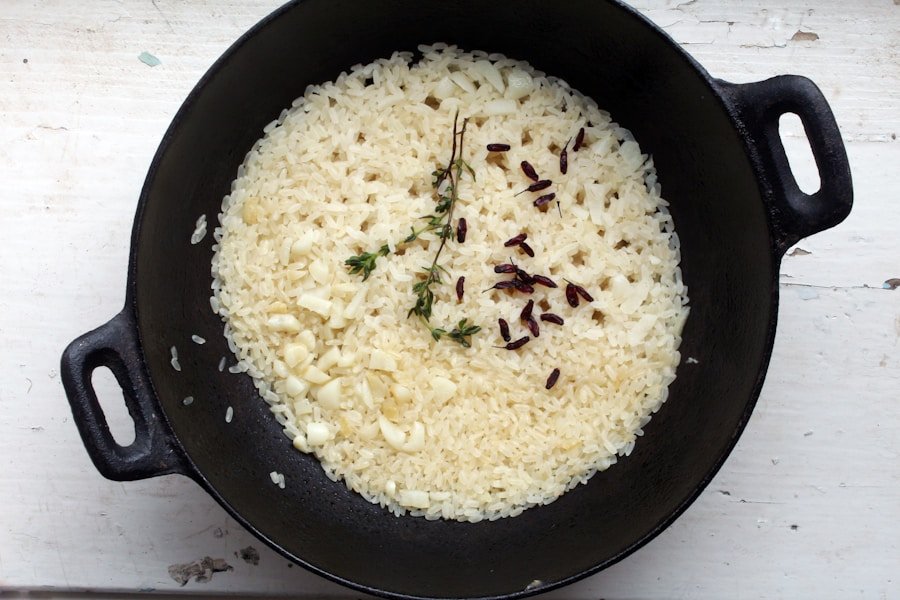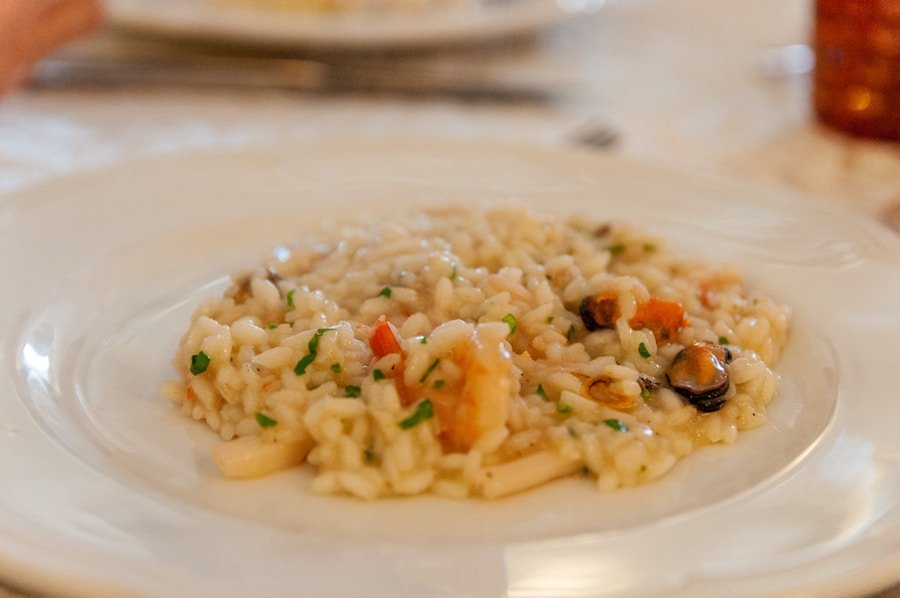Risotto is a classic Italian dish that has captured the hearts and palates of food lovers around the world. At its core, risotto is a creamy rice dish made primarily from Arborio, Carnaroli, or Vialone Nano rice, which are varieties known for their high starch content. This starch is what gives risotto its signature creamy texture, allowing it to be both rich and comforting without the need for heavy additives.
Traditionally, risotto is cooked slowly, with the rice absorbing broth gradually, which enhances its flavor and texture. The beauty of risotto lies in its versatility; it can be customized with a variety of ingredients, from seasonal vegetables to seafood and meats. Each region in Italy boasts its own unique take on risotto, reflecting local ingredients and culinary traditions.
For instance, Risotto alla Milanese is famous for its saffron infusion, while Risotto al Nero di Seppia features cuttlefish ink for a striking black color. This adaptability makes risotto not only a staple in Italian cuisine but also a canvas for culinary creativity.
Key Takeaways
- Risotto is a creamy Italian rice dish made with Arborio rice, broth, and often flavored with ingredients like cheese, vegetables, or seafood.
- The traditional way to make risotto involves slowly adding hot broth to the rice and stirring constantly to release the starches and create a creamy texture.
- Heavy cream is not necessary for creamy risotto; the starches in the rice and the addition of cheese can create a rich and creamy texture.
- Alternative ingredients for creaminess include using a combination of butter and cheese, pureed vegetables, or even a splash of white wine.
- Tips for achieving creamy risotto include using the right type of rice, adding hot broth gradually, and stirring constantly to release the starches.
The Traditional Way to Make Risotto
The Toasting Step
First, the rice is toasted in a pan with a bit of oil or butter, which helps to enhance its nutty flavor and prepares it to absorb the liquid more effectively. This initial step is crucial as it sets the foundation for the dish’s overall taste profile.
Sautéing and Coating the Rice
After toasting, finely chopped onions or shallots are often added to the pan, sautéed until translucent, and then the rice is coated in this aromatic mixture. Once the rice is ready, the cooking process begins with the gradual addition of warm broth—typically chicken or vegetable stock.
The Slow Cooking Process
The key here is to add the broth one ladle at a time, allowing the rice to absorb the liquid fully before adding more. This slow cooking method encourages the release of starch from the rice grains, resulting in that coveted creamy consistency. Stirring frequently not only prevents the rice from sticking to the bottom of the pan but also helps to incorporate air into the mixture, further enhancing its creaminess. The process can take anywhere from 18 to 25 minutes, depending on the type of rice used and the desired level of doneness.
Why You Don’t Need Heavy Cream

A common misconception about risotto is that it requires heavy cream to achieve its signature creaminess. While cream can certainly add richness, it is not necessary for creating a delicious risotto. The starch released from the rice during cooking is sufficient to create a velvety texture without the need for additional dairy products.
In fact, many traditional recipes do not include heavy cream at all; instead, they rely on the natural properties of the rice and the flavors of the broth. Using heavy cream can sometimes mask the delicate flavors of other ingredients in the dish. By omitting cream, cooks can allow the natural flavors of vegetables, herbs, and proteins to shine through.
Additionally, heavy cream can make risotto overly rich and heavy, which may not be appealing to everyone. By focusing on technique and quality ingredients, one can create a light yet satisfying dish that highlights the essence of Italian cooking.
Alternative Ingredients for Creaminess
| Alternative Ingredient | Creaminess Rating (out of 10) |
|---|---|
| Coconut Milk | 8 |
| Cashew Cream | 9 |
| Soy Milk | 7 |
| Avocado | 9 |
| Plain Yogurt | 8 |
To achieve that desired creamy texture without resorting to heavy cream, there are several alternative ingredients that can be incorporated into risotto recipes. One popular option is to use a splash of white wine during the cooking process. The acidity of wine not only adds depth of flavor but also helps to enhance the creaminess by promoting starch release from the rice.
Another excellent alternative is to incorporate pureed vegetables or legumes into the risotto. For example, adding pureed butternut squash or cauliflower can provide both creaminess and a subtle sweetness that complements savory elements in the dish. Additionally, using nutritional yeast can impart a cheesy flavor while contributing to a creamy texture without dairy.
Finally, incorporating a small amount of butter or high-quality olive oil at the end of cooking can enrich the dish further while maintaining its lightness.
Tips for Achieving Creamy Risotto
Achieving creamy risotto requires attention to detail and a few key techniques that can elevate your dish from good to exceptional. First and foremost, selecting the right type of rice is crucial; Arborio rice is most commonly used due to its high starch content, but Carnaroli and Vialone Nano are also excellent choices known for their ability to absorb liquid while maintaining a firm bite. Another important tip is to ensure that your broth is warm when added to the rice.
Cold broth can shock the cooking process and disrupt the release of starches, leading to uneven cooking and a less creamy texture. Stirring frequently throughout the cooking process is also essential; this not only helps prevent sticking but also encourages even cooking and promotes creaminess by incorporating air into the mixture. Finally, allowing your risotto to rest for a minute or two after cooking before serving can help it thicken slightly and achieve an even creamier consistency.
Recipes for Creamy Risotto Without Heavy Cream

One delightful recipe for creamy risotto without heavy cream features asparagus and lemon zest. Begin by sautéing finely chopped onions in olive oil until translucent, then add Arborio rice and toast it lightly. Gradually add warm vegetable broth while stirring continuously.
When the rice is nearly al dente, fold in blanched asparagus pieces and finish with a squeeze of fresh lemon juice and a sprinkle of lemon zest for brightness. Another enticing option is mushroom risotto with thyme. Start by sautéing a mix of wild mushrooms in butter until golden brown; set aside.
In the same pan, cook onions until soft before adding Arborio rice. Gradually incorporate warm chicken broth while stirring frequently. Once creamy and cooked through, fold in the sautéed mushrooms and fresh thyme leaves for an earthy flavor profile that pairs beautifully with the creamy texture.
Health Benefits of Creamy Risotto Without Heavy Cream
Making creamy risotto without heavy cream not only enhances its flavor but also offers several health benefits. By avoiding heavy cream, you reduce saturated fat content significantly, making it a lighter option that can fit into various dietary preferences. This is particularly beneficial for those who are watching their cholesterol levels or seeking healthier meal options.
Moreover, using fresh vegetables or legumes as alternatives not only adds creaminess but also boosts nutritional value. For instance, incorporating pureed spinach or peas increases fiber content while providing essential vitamins and minerals such as vitamin K and folate. Additionally, using high-quality broth made from fresh ingredients can enhance flavor without unnecessary additives or preservatives found in some commercial products.
Serving Suggestions for Creamy Risotto
When it comes to serving creamy risotto, presentation plays an important role in enhancing the dining experience. A simple yet elegant way to serve risotto is by plating it in shallow bowls or wide plates, allowing for an attractive display of colors and textures. Garnishing with fresh herbs such as parsley or basil adds a pop of color while contributing fresh flavors that complement the dish.
Pairing risotto with complementary side dishes can elevate your meal further. A crisp green salad dressed with a light vinaigrette provides a refreshing contrast to the richness of risotto. Alternatively, serving it alongside grilled proteins like chicken or fish can create a well-rounded plate that balances flavors and textures beautifully.
For those looking to indulge further, consider topping your risotto with shaved Parmesan cheese or toasted pine nuts for added depth and crunch. In conclusion, risotto stands as a testament to Italian culinary tradition—an adaptable dish that celebrates simplicity while allowing for creativity in flavor combinations and textures. By mastering traditional techniques and exploring alternative ingredients for creaminess, anyone can create delicious variations of this beloved dish without relying on heavy cream.
If you’re looking to elevate your cooking game beyond just making creamy risotto without heavy cream, you may want to check out this article on 5 Most Useful Kitchen Technology Innovations. This article highlights some of the latest kitchen gadgets and tools that can help streamline your cooking process and make your time in the kitchen more efficient and enjoyable. Whether you’re a seasoned chef or just starting out, these innovations can help take your culinary skills to the next level.
FAQs
What is risotto?
Risotto is a traditional Italian dish made with Arborio rice, broth, and other ingredients such as vegetables, meat, or seafood. It has a creamy consistency and is often served as a main course.
Can risotto be made without heavy cream?
Yes, risotto can be made without heavy cream. The creamy texture of risotto comes from the starch in the Arborio rice and the constant stirring during the cooking process, rather than from heavy cream.
What can be used instead of heavy cream in risotto?
Instead of heavy cream, you can use ingredients such as butter, Parmesan cheese, and a small amount of broth to achieve a creamy texture in risotto. These ingredients help to create a rich and creamy consistency without the need for heavy cream.
How do you make creamy risotto without heavy cream?
To make creamy risotto without heavy cream, start by sautéing the Arborio rice in butter, then gradually add warm broth and stir constantly until the rice is cooked and the mixture is creamy. Finish by stirring in grated Parmesan cheese to add richness and creaminess to the risotto.
Is risotto without heavy cream still creamy?
Yes, risotto made without heavy cream can still have a creamy texture. The starch in the Arborio rice, along with the addition of butter and Parmesan cheese, helps to create a creamy consistency without the need for heavy cream.

